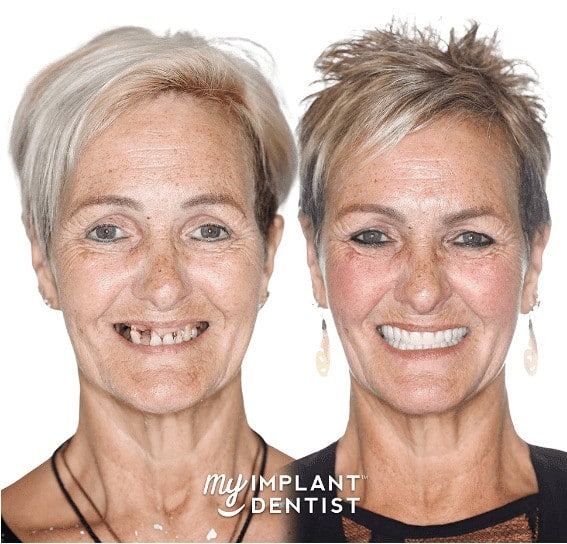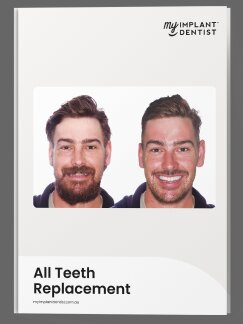- Depending on the type of procedure, replacing missing teeth can be costly.
- There are various options available to replace your missing teeth, ranging from dentures to dental implants and bridges.
- For each option, there is a different procedure that must be followed to ensure successful results.
- Consult your dentist before making any final decisions regarding replacing missing teeth. They will be able to advise you on the best treatment plan based on your dental history and needs as well as provide information about potential risks associated with each option.
- Taking care of your replacement teeth is essential to ensure they last as long as possible.

Contents
- 1 Why Should You Replace Missing Teeth?
- 2 What Are The Treatment Options For Replacing Missing Teeth?
- 3 Which Option Is Right For Me?
- 4 faqs
- 4.1 What Is The Best Option For Replacing Missing Teeth?
- 4.2 Can You Get A Denture For One Missing Tooth?
- 4.3 What Are Permanent Fake Teeth Called?
- 4.4 What Happens If I Don’t Replace A Missing Tooth?
- 4.5 Can You Replace All Your Teeth At Once?
- 4.6 How Long Can You Go With A Missing Tooth?
- 4.7 Which Is Better Fixed Bridge Or Dentures?
- 4.8 What To Do With Multiple Missing Teeth?
- 5 Conclusion
Missing teeth can be embarrassing and have a serious impact on your overall confidence and self-esteem. Fortunately, thanks to modern dentistry, there are various options to replace missing teeth that are both affordable and effective.
When considering a tooth replacement procedure, it’s important to understand the different treatments available, their associated costs, and the steps involved in each procedure.
The good news is, with the right guidance, you can make an informed decision that will leave you with a beautiful smile. Let’s take a closer look at the different types of tooth replacement, their associated costs and the steps involved.
Why Should You Replace Missing Teeth?
Missing teeth can lead to a host of issues, including shifting of the teeth, gum disease, problems with your speech, and a decrease in your self-confidence. Replacing missing teeth is important for more than just aesthetic reasons.
A full set of healthy teeth can help you eat and digest food better, speak with clarity, and keep your other teeth in place. Replacing missing teeth also helps maintain the shape of your face.
Having a complete set of healthy teeth can also help improve your overall health by making sure that all your other vital organs are functioning correctly.
Missing or damaged teeth can make it difficult to chew properly, leading to poor digestion and nutritional deficiencies that can lead to other health issues.
Replacing missing or damaged teeth also helps protect the rest of your oral structure from decay and disease by preventing gaps where bacteria and plaque can build up. It’s important to replace any missing or damaged teeth as soon as possible to prevent further damage from occurring.
What Are The Treatment Options For Replacing Missing Teeth?
Ninety-two per cent of adults aged 20 to 64 have cavities, according to the National Health and Nutrition Examination Survey (NHANES). People who are missing teeth also make up a sizable population segment. There are a variety of options available thanks to the many advances in dentistry that have occurred in recent decades.
Dental Implants
Dental implants are titanium posts that are implanted into the jaw beneath the gums. They are anchored into the jaw and function as artificial teeth.
Dental implants may not be the ideal choice for replacing a full arch of teeth, but they do a great job of replacing a single tooth. However, dental implants replicate the appearance and function of natural teeth and can survive for many years.
Types of Dental Implants
1. Endosteal Implants
Endosteal implants are a type of dental implant that is surgically embedded into the jawbone to replace missing teeth. They are the most commonly used type of dental implant.
Endosteal implants are made from titanium and other biocompatible materials that make them strong enough to withstand the forces of biting and chewing.
2. Subperiosteal Implants
Subperiosteal implants, unlike traditional implants, require a lengthy healing period and require significant bone structure. Subperiosteal implants are placed beneath the gum line, directly on top of the existing jawbone.
A metal frame is placed under the gum with a post attached to it. This makes them ideal for patients who have had extensive tooth loss due to age, disease or trauma.
3. All-on-4 Dental Implants
The All-on-4 implants involve replacing an entire upper or lower arch of teeth with a set of dental implants. A fresh set of permanent teeth can be secured in place by these four implants. All-on-4 dental implants are often a viable option for adults who want to avoid dentures. A small titanium screw is placed into your jaw which replaces the root of the missing tooth. This requires a small surgery.
Once that is done, a crown is connected, with the result being a very real-looking and functional tooth.
Procedure
A dental implant procedure usually takes several months to complete.
1. Initial Consultation & Preparation
Your dental practitioner will do a thorough examination of your teeth and gums. The dentist will use a CBCT or CT scan at this stage. Either scan can be used to provide a thorough look at the potential implant site.
In this step, teeth are extracted or bone is restored or grafted to prepare a solid foundation for the implant.
2. Placement of the Implant
The dentist will place the implant once the incisions have healed and it has been determined that the placement is suitable. The implant process typically takes between three and six months to complete.
3. Whole Mouth Impression
A dentist will take a full impression of the mouth to make a crown.
4 Installing the Crown
If the implant has healed sufficiently, a crown can be placed on it. Because it is based on an impression, the crown should feel and look just like the real thing.
Costs
Dental implant costs are based on several factors, including the complexity of the procedure, the number of teeth that need to be replaced, and the dentist’s location.
The cost of dental implants in Australia might vary between $5,000 and $7,500. The average cost per tooth in 2017 was about $5,563, but you’ll need a substantial down payment to get financed.
Pros and Cons
Pros:
- Dental implants look and feel like natural teeth.
- Implants can last a lifetime with the right care.
- They help preserve healthy bone structure in your jaw.
- Dental implants reduce the risk of gum disease or other complications associated with missing teeth.
Cons:
- Dental implants are more expensive than other options, such as dentures or bridges.
- The procedure is lengthy and may require multiple visits to the dentist.
- You must have adequate bone density in your jaw for successful implant placement.
Dental Bridges
A dental bridge consists of an artificial tooth (called a pontic) placed between two crowns (called abutment teeth) on either side of a gap.
Pontics can be crafted from a wide range of materials, including precious metals like gold, but the most common material is porcelain because it most closely resembles real teeth.
Types
1. Traditional Bridges
They require a crown for the teeth, an implant on either side of the gap, and a pontic to bridge the space. Commonly used bridges are called “traditional” and can be crafted from either porcelain fused to metal or ceramics.
2. Cantilever Bridges
They are used to replace one or more missing teeth when just teeth on one side of the gap need to be replaced. This is not encouraged, especially in the back of the mouth, where it might cause excessive force on the other teeth and cause them to break.
3. Maryland Bonded Bridges
They contain a metal or porcelain structure with porcelain bonded to metal or plastic teeth and gums. The bridge is attached to your existing teeth using metal or porcelain wings on either side of the gap.
Procedure
The dental bridge procedure is simple and straightforward, depending on your needs.
1. Dental Exam
During your initial exam, your dentist will take X-rays and impressions of your mouth to determine if you are a good candidate for a dental bridge.
2. Preparation of Adjacent Teeth
To anchor the bridge in place, the adjacent teeth must be filed down slightly to make room for the crowns that will hold it in place.
3. Making an Impression
An impression is taken of your mouth so that a custom-made bridge can be created for you by a dental laboratory technician.
4. Placement of Temporary Bridge
A temporary bridge is placed while you wait for your custom bridge to be made at the lab. This helps protect exposed gums and teeth while you wait for your permanent restoration to arrive from the lab.
5. Final Fitting & Cementing
Once your custom-made dental bridge arrives back from the lab, it is tried in, and you and your dentist have determined that the appearance, bite, and fit are all satisfactory, permanent cement will be used.
Costs
Traditional dental bridges in Australia can cost from $5,000 per bridge for a three-unit fixture, plus another $1,200 to $2,400 for two crowns. Additionally, the price of a pontic, or false tooth, can be anywhere from $800 to $1,200.
Dental bridges are extremely costly. Although costly, dental bridges offer several benefits, including the elimination of the need for dentures in the long run.
Pros and Cons
Pros:
- Dental bridges look and feel natural, just like real teeth.
- Bridges can help maintain facial shape and prevent premature wrinkles or sagging in the face.
- Bridges can provide greater stability than other tooth replacement options, such as dentures or implants.
- They can help restore your ability to chew food properly, making it easier to eat a variety of foods.
- They also help restore your ability to speak clearly by providing an anchor for the tongue that prevents the slurring of words.
Cons:
- Dental bridges require some preparation of the surrounding teeth before being placed, which may involve filing down existing teeth or using dental crowns to anchor the bridge in place.
- Dental bridges may not last as long as implants or dentures if not taken care of properly or if you have other underlying oral health issues such as gum disease or decay.
- Depending on the type of bridge chosen, there may be additional costs associated
Dentures
Dentures are prosthetic teeth and gums that are custom-made to replace missing teeth. They can be made of a variety of materials, including acrylic resin, nylon, metal, and porcelain. Dentures are removable appliances that fit snugly over the gums to replace lost or missing teeth.
Types
1. Full Dentures
Full dentures replace all teeth in the upper or lower jaw. These dentures sit on top of your gums, providing support and stability without relying on any remaining natural teeth.
2. Partial Dentures
These dentures are used when one or more natural teeth remain in the upper or lower jaw. They can be made from metal and acrylic or just acrylic. The metal framework helps keep the denture firmly in place while helping to reduce the amount of tissue coverage required for support.
3. Implant-supported Dentures
They use an implant-retained bar that is securely attached to dental implants placed into your jawbone for a secure fit that won’t slip or move while you’re eating or speaking.
4. Fixed Bridge
A fixed bridge is a method of dental replacement in which a crown (an artificial tooth) is cemented to two crowns on either side of a gap.
5. Snap-on Dentures
Snap-on dentures are removable crowns that snap onto implants surgically placed in the jawbone. Your dentures will stay put throughout even the most vigorous chewing, allowing you to enjoy all your favourite foods without restriction.
Procedure
1. Consultation
The first step in the process is to meet with your dentist and discuss your needs, budget, and any issues related to your dental health. Your dentist will help create a plan that works best for you.
2. Dental Impressions and Measurements
Next, your dentist will take precise measurements of your mouth by taking impressions of it. This information will be used to create a custom-fitted set of dentures that fit perfectly in your mouth.
3. Fabrication
After the impressions are taken, they will be sent off to a lab where skilled technicians will fabricate the dentures according to the specifications provided by your dentist.
4. Fitting
Once the dentures have been fabricated, you’ll need to come back into the office for a fitting appointment, where they’ll be fitted and adjusted until they’re just right for you!
5. Care Instructions for Your New Dentures
Your dentist will provide detailed instructions on how to properly care for and maintain your new set of dentures so that they last as long as possible with proper use and care.
Costs
The cost of dentures varies depending on the denture-making process and materials used.
Low-cost dentures: cost $300-$500 for each plate, with a full set of lower and upper dentures running $600-$1,000.
Mid-priced dentures: cost between $1,000 and $3,000 for a whole set and between $500 and $1,500 for a single denture plate.
Premium range: from $2,000-$4,000/denture; $4,000-$8,000/complete set)
Pros and Cons
Pros:
- Dentures are relatively inexpensive compared to other tooth replacement options, such as dental implants.
- Dentures can improve the appearance of a person’s smile and boost their self-confidence.
- Dentures are custom-made to fit each individual’s mouth, providing a comfortable fit that doesn’t slip or move around when speaking or eating.
Cons:
- It can take several months for a person to become accustomed to wearing dentures since they need time to adjust and get used to them.
- Regular adjustments may be needed as the gums, and bone structure beneath the dentures change over time.
- There is an increased risk of gum disease due to bacteria collecting around the edges of the denture plate near the gums.
Which Option Is Right For Me?
If you’re considering tooth replacement options, it’s important to understand what each option offers. Each type of tooth replacement has its own unique benefits and drawbacks, so it’s important to do your research and find the right solution for your needs.
The type of tooth replacement option you choose will depend on various factors, including the location and number of teeth you are missing.
faqs
What Is The Best Option For Replacing Missing Teeth?
Dental implants are the preferred method of replacing missing teeth.
Can You Get A Denture For One Missing Tooth?
Yes you can
What Are Permanent Fake Teeth Called?
Crown
What Happens If I Don’t Replace A Missing Tooth?
It can lead to bacterial infections and gum disease. The positioning of your remaining teeth is also altered.
Can You Replace All Your Teeth At Once?
Yes, you can. It’s a new technique that allows you to get all your teeth done in one appointment.
How Long Can You Go With A Missing Tooth?
Not for long. Because it predisposes you to infection and can alter the alignment of your teeth.
Which Is Better Fixed Bridge Or Dentures?
A removable denture cannot compare to the advantages of a fixed bridge. A fixed bridge will look and function just like your original teeth and last for the rest of your life. Depending on how well you take care of them, these teeth could last anywhere from 10 to 20 years with proper maintenance.
What To Do With Multiple Missing Teeth?
When numerous teeth are missing, either a fixed bridge supported by the neighbouring teeth, a removable partial denture supported by claps on the neighbouring teeth, or an implant restoration can be used to fill the gap.
Conclusion
Dental implants are the most popular and effective way to replace missing teeth. Implants come in different types and strengths. The best option will depend on your personal situation and goals.
Dental implants are usually more expensive than other options, such as dentures or bridges. But you should be able to get them financed if you have a good credit history and have other funds available to cover the cost.
They can be left in place for many years without needing to be replaced. Additionally, they may be able to help prevent the development of gum disease or other problems associated with missing teeth.
To get a replacement for your lost teeth, visit My Implant Dentist. Our techniques guarantee a healthy and much better replacement.




















